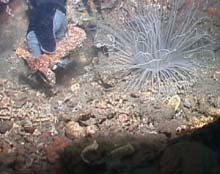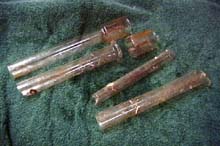
An archaeologist recovers a brass handle from a bayonet after mapping its location within the wreck. Tentative identification leads sanctuary staff to believe it from a Sharps & Hankins model rifle. In 1998, a musket butt plate recovered in the same area has been identified as belonging to one of three models of Sharps & Hankins muskets. (Monitor Collection, NOAA) Click image for larger view.

The most prevalent type of artifacts recovered from the Monitor is whale-oil lamp chimneys. These glass tubes--remarkably, one was intact--were recovered in April during Phase I of the Monitor 2001 expeditions. (Monitor Collection, NOAA) Click image for larger view.
Progress Report - NOAA Phase I
April 15, 2001
John Broadwater, Manager
Monitor National Marine Sanctuary
The NOAA team is composed of divers from NOAA, the National Undersea Research Center at the University of North Carolina at Wilmington, the Maritime Studies Program ![]() at East Carolina University, and the Cambrian Foundation
at East Carolina University, and the Cambrian Foundation ![]() . Our team uses “technical diving” techniques, a highly specialized form of scuba diving. The divers breathe a special mixture of oxygen, helium and nitrogen, and dive in teams for safety. We also decompress (slowly return to surface pressure) in the water for an hour or more to prevent "the bends," a painful condition caused by too many gaseous bubbles building up in the bloodstream.
. Our team uses “technical diving” techniques, a highly specialized form of scuba diving. The divers breathe a special mixture of oxygen, helium and nitrogen, and dive in teams for safety. We also decompress (slowly return to surface pressure) in the water for an hour or more to prevent "the bends," a painful condition caused by too many gaseous bubbles building up in the bloodstream.
We documented a number of measurements and observations for the Navy, including features on the engine recovery structure (ERS), the condenser, steam piping, fire room and armor belt. We placed a strap on the hull to mark the approximate center of gravity of the engine/hull structure to be recovered. We documented the position of the ERS and lifting frame in relation to the wreck. These activities generated more than an hour of excellent videotape.
Recovered Artifacts
In the stern, we found two concentrations of artifacts that were likely to be damaged during the engine recovery process. The recovered objects include glass condiment bottles, glass whale-oil lamp chimneys, a brass lamp heat deflector, an intact ironstone saucer, and a bayonet handle. Amazingly, the lamp chimneys apparently were stored in the aft part of the engine room until they fell through a hole in the deck near the turret. One is completely intact and the others are only chipped. All of the artifacts have been turned over to The Mariners' Museum ![]() in Newport News, VA, for conservation. Some artifacts had t be left in place because they were tightly cemented into a large concretion (a mass of corroded materials) in the stern. They will have to be recovered by Navy divers.
in Newport News, VA, for conservation. Some artifacts had t be left in place because they were tightly cemented into a large concretion (a mass of corroded materials) in the stern. They will have to be recovered by Navy divers.
With NOAA's results in hand, the Navy is now preparing the lifting equipment for this summer’s engine recovery operation.
Sign up for the Ocean Explorer E-mail Update List.






















